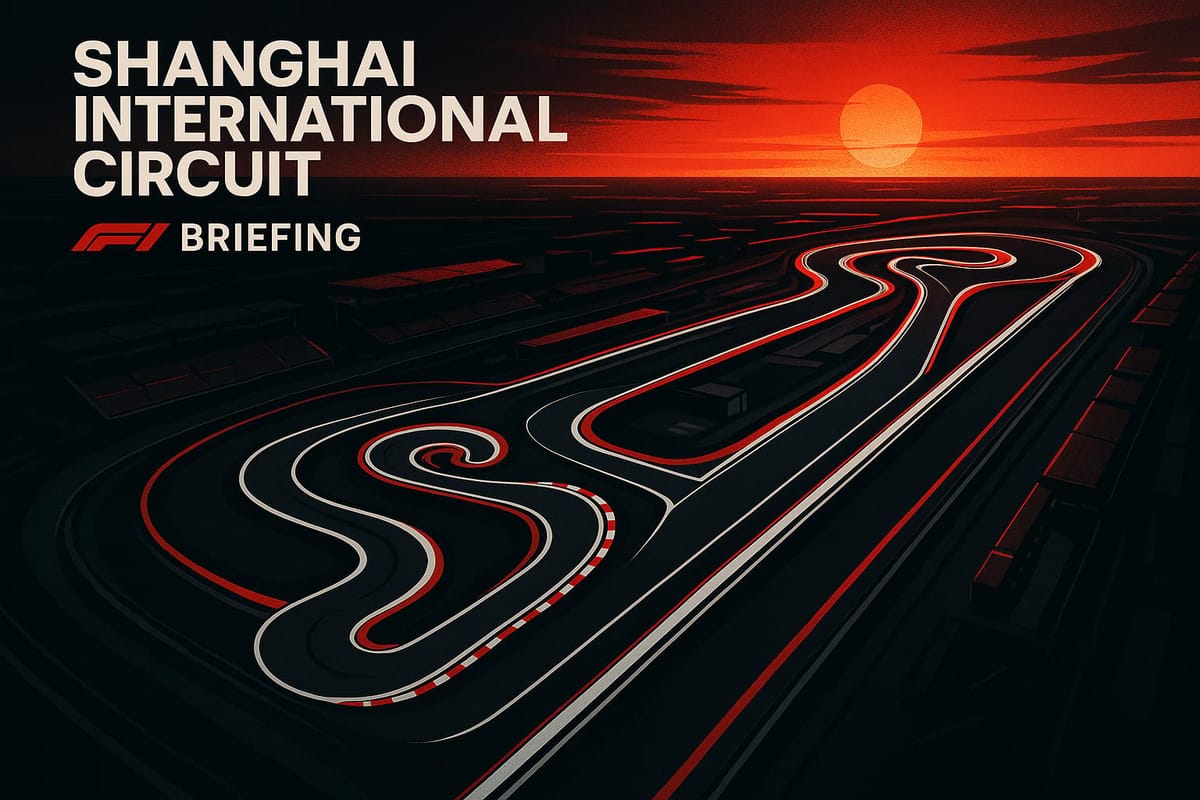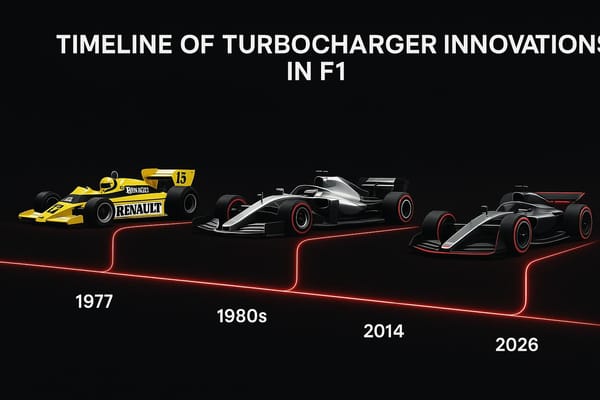Shanghai International Circuit: A Technical Masterpiece Behind the Chinese Grand Prix
Explore the intricate design and challenges of the Shanghai International Circuit, a premier venue for the Chinese Grand Prix.

- Track Length: 3.387 miles (5.451 km)
- Key Features: 16 turns, a 1,170-meter straight, and a 270-degree Turn 1-3 complex.
- Cost & Construction: Built for $450M in 18 months, overcoming swampy terrain.
- Racing Highlights: Known for overtaking opportunities, extended DRS zones, and high tire wear.
- Recent Updates: Extended DRS by 75 meters and track resurfacing in 2025.
The circuit demands precision driving, strategic tire management, and aerodynamic balance. Notably, Oscar Piastri set an unofficial qualifying record of 1:30.641 in 2025, showcasing its technical complexity.
Chinese GP Track Analysis – Everything You Need to Know! 🇨🇳 🏁
Circuit Design and Layout
The Shanghai International Circuit is a showcase of modern engineering and strategic design, brought to life by Hermann Tilke's expertise. Its layout combines technical demands with thrilling racing opportunities, making it a standout venue in motorsport.
Design Origins
The circuit's construction on Shanghai's swampland posed significant challenges, requiring innovative engineering solutions to ensure stability and performance. The design philosophy aimed to balance difficulty with drivability, offering a track that could cater to a variety of car setups. This approach encourages diverse race strategies, adding an extra layer of excitement to race weekends. Additionally, the circuit was designed with spectators in mind, featuring carefully planned viewing angles and accessibility to accommodate up to 200,000 fans.
Track Sections Analysis
Each sector of the circuit presents its own set of challenges, reflecting the thoughtful design principles behind the track:
| Sector | Key Features | Technical Demands |
|---|---|---|
| Sector 1 | Turns 1–4 complex | Requires precise engine braking and smooth speed reduction |
| Sector 2 | Turns 7–8 chicane | Sustains 3G forces, with speeds dropping to around 99 mph (160 km/h) |
| Sector 3 | 0.727-mile straight | Drivers hit full throttle for 17–18 seconds, leading into a hairpin at Turn 14 |
Sector 1 challenges drivers with a series of tight turns requiring careful braking and control. Sector 2 pushes physical limits, as drivers endure sustained G-forces through a high-speed chicane. Meanwhile, Sector 3's long straight offers prime opportunities for overtaking, particularly as it flows into the Turn 14 hairpin.
Track Specifications
Recent updates to the track surface have sparked mixed reactions from drivers. Daniel Ricciardo commented:
"It looks like they've painted the track or something. They've done something to the surface. I don't know how the track's going to change, or if it's going to be the same or super slippery. But maybe that changes the way the tires behave."
Ayao Komatsu, Technical Director, shared concerns about the surface's consistency:
"I think it looks a bit inconsistent. That inconsistency is what I worry about the most - the inconsistency from entry to mid-corner to exit in each corner. If it's variable, that's going to be pretty tricky."
Key technical details of the circuit include:
| Feature | Specification |
|---|---|
| Maximum G-Force | 3G (at Turns 7–8) |
| Spectator Capacity | 200,000 |
These elements highlight the intricate balance of technical and performance demands that make the Shanghai International Circuit a true test for both drivers and engineers.
Racing Line and Track Features
The Shanghai International Circuit stands out as a track that demands both technical skill and strategic planning. Its unique layout creates chances for drivers to attack and defend, making it a fascinating challenge for teams and racers alike.
Turn 1-3 Complex
The Turn 1-3 sequence is a standout feature of the circuit - a sweeping 270-degree right-hand turn that tests the limits of both drivers and their machines. This demanding section puts heavy strain on the front-left tire, requiring drivers to carefully balance speed and grip to avoid understeer.
| Corner Phase | Technical Challenge | Driver Focus |
|---|---|---|
| Entry | Precise braking | Managing tire temperatures |
| Mid-corner | Avoiding understeer | Protecting the front-left tire |
| Exit | Maximizing traction | Positioning for the straight |
Passing Zones
Overtaking is a key part of racing at Shanghai, and the circuit offers several opportunities to make it happen. The most notable is the 1.2-kilometer (0.75-mile) back straight, which leads into the tight Turn 14 hairpin. This combination of a long straight, DRS activation, and a heavy braking zone gives drivers multiple options for attacking and defending.
| Zone | Characteristics | Strategic Importance |
|---|---|---|
| Back Straight | DRS zone, 1.2 km length | Primary area for overtaking |
| Turn 14 Hairpin | Heavy braking zone | Allows varied racing lines |
These zones create high-pressure moments where drivers must make split-second decisions to gain or defend positions.
Driver Perspectives
The circuit's technical demands have sparked plenty of discussion among drivers and teams. McLaren's team principal, Andrea Stella, highlighted the challenges faced during a recent race:
"Definitely we have some improvements to do in the long run, because with Lando we had quite a lot of graining and he couldn't make much progress during the sprint, while Oscar coped with the tyres a bit more comfortably. But it's also true that Oscar had less dirty air, which is also important here."
Pirelli’s motorsport boss, Mario Isola, provided additional insight into tire management at Shanghai:
"I believe it's more about looking after the front left in the first couple of laps. Here you have a straight and then you have a 270-degree turn that is stressing immediately the front-left tyre when it's still not at the optimal temperature and pressure. That means that you can start generating graining there, and if you manage this, then a two-stop is feasible."
Recent resurfacing of the track has added grip, which has forced teams to rethink their strategies. Early laps are now a delicate balance between pushing for position and carefully managing tire wear to avoid compromising performance later in the race.
Race Setup and Performance
The Shanghai International Circuit challenges teams to fine-tune setups that balance straight-line speed with cornering grip. These technical tweaks play a pivotal role in both qualifying lap times and overall race strategy.
Aero Setup Options
Shanghai's layout calls for a medium-to-high downforce configuration to maintain stability through its sweeping corners while preserving speed on the straights. The track’s relatively low grip level adds an extra layer of complexity to these decisions.
| Setup Element | Recommended Configuration | Purpose |
|---|---|---|
| Front Wing | High angle setting | Provides extra grip at Turn 1 |
| Rear Wing | Medium-high setting | Balances speed with stability |
| Front Suspension | Stiffer configuration | Enhances cornering response |
| Tire Pressure | Lower front-left pressure | Reduces heat buildup |
After qualifying, teams often adjust the front wing angle to improve straight-line speed during the race. This delicate aero balance also plays a critical role in managing tire wear, which is another key factor at this circuit.
Tire Wear and Pit Stops
Tire management is just as important as aerodynamic setup when it comes to Shanghai's unique demands. The circuit is notorious for front-left tire graining, requiring strategic planning to maintain competitive pace.
Mario Isola, Pirelli's motorsport chief, shed light on the challenges:
"From what we collected from the sprint, the front-left graining is still there and the wear of the medium with 19 laps is quite high. For some teams it was at the limit, that means we believe it's a two-stop strategy; medium-hard-hard."
In 2025, teams are focusing on these key tire strategies:
| Strategy Element | Key Consideration | Impact |
|---|---|---|
| Initial Phase | Gentle tire warm-up | Prevents early graining |
| Mid-Race | Two-stop strategy | Extends overall tire life |
| Final Stint | Hard compound preference | Ensures consistent performance |
By carefully managing these phases, teams aim to strike the perfect balance between pace and tire longevity.
DRS Zone Impact
The FIA has extended the DRS zone on Shanghai's back straight by 75 meters for the 2025 season, starting 375 meters after Turn 13. This adjustment introduces new strategic opportunities for overtaking.
George Russell from Mercedes commented on the importance of DRS:
"DRS is there to aid overtaking and it's always exciting when you've got these big DRS advantages, and it gives you the opportunity to fight."
The extended DRS zone, combined with the circuit's resurfacing, gives teams more room to experiment with setups. Balancing straight-line speed and cornering stability remains crucial, as reflected in the track’s 3/5 downforce rating.
Track History and Development
The Shanghai International Circuit came to life through a government-backed joint venture with a hefty $450 million investment. Construction began in April 2003 and wrapped up impressively in just 18 months. This rapid development set the stage for some unforgettable moments in motorsport.
Key Racing Moments
The circuit's debut Formula One race in 2004 was a landmark event in motorsport. Mercedes-Benz's motorsport director, Norbert Haug, underscored its importance:
"In my view this is a very important race, probably the most important race in the history of motorsport."
Since then, the track has consistently tested drivers' skills. Michael Schumacher still holds the official race lap record with a time of 1:32.238, while Oscar Piastri clocked an unofficial qualifying record of 1:30.641 in 2025.
Track Updates
Over the years, the circuit has undergone several upgrades aimed at improving both the racing experience and safety:
| Year | Update | Impact |
|---|---|---|
| 2017 | Resurfaced start line and reinforced barriers | Smoothed out a troublesome bump and boosted safety at Turns 1 and 8 |
| 2024 | Bitumen surface treatment | Enhanced surface durability and waterproofing |
However, earlier resurfacing efforts sparked debates about the track's surface consistency. Despite these challenges, ongoing improvements continue to shape the circuit's racing dynamics and reputation.
Future Development Plans
Looking ahead, the Shanghai International Circuit is expanding its role beyond Formula One. Since 2024, it has hosted the Shanghai ePrix. The venue boasts a total capacity of 200,000, including a 30,000-seat main grandstand. Its team buildings, inspired by the traditional design of Shanghai's Yu Garden, add a unique touch to the sprawling 5.3 km² (2.0 square miles) site. Accessibility is a priority, with six-lane highways ensuring smooth entry.
As a 4A-rated tourist attraction, the circuit blends cultural elements with technical sophistication. Its design, inspired by the Chinese character "shang" (上), includes one of Formula One's longest straights at 1.2 km (0.7 miles), making it a standout venue in the racing world.
Conclusion
The Shanghai International Circuit stands as a testament to modern motorsport engineering, merging cutting-edge design with a nod to local heritage. Its layout, inspired by the Chinese character "shang" (上), delivers a distinctive challenge for drivers and teams alike, pushing the limits of both skill and technology.
The track's defining features, such as the 1.2 km (0.7 mi) straight and the intricate Turn 1-3 complex, demand a perfect balance between speed and control. This balance was highlighted by Oscar Piastri's unofficial 1:30.641 qualifying record in March 2025, showcasing the circuit's ability to test the very best.
Simone Berra, Pirelli's Formula 1 chief engineer, captured the essence of the circuit's evolution:
"It's like a new circuit, honestly. Because we have new cars, new tyres, the 18-inch [rims]."
With a $450 million investment, the venue combines world-class facilities with a design that respects and reflects local culture, while also pushing the boundaries of motorsport technology.
The track's unique characteristics - ranging from its technical corners and long straights to its variable surface conditions - play a crucial role in shaping race strategies. Teams must carefully consider tire performance and aerodynamic setups, making it one of the most challenging circuits in Formula One.
As the sport evolves with new racing formats and technical rules, the Shanghai International Circuit continues to adapt, ensuring it remains a benchmark for driver skill and engineering ingenuity in the ever-advancing world of motorsport.
FAQs
What challenges did engineers face when building the Shanghai International Circuit on swampy land, and how were they resolved?
Building the Shanghai International Circuit on swampy ground was no small feat. The construction team, under the guidance of famed designer Hermann Tilke, faced the challenge head-on with cutting-edge engineering methods. One of their key strategies involved driving thousands of concrete piles deep into the soft, waterlogged soil to create a solid foundation.
Beyond that, they undertook meticulous ground preparation to ensure the track could withstand both the immense weight of the cars and the intense forces generated during high-speed racing. These efforts transformed the swampy terrain into a state-of-the-art Formula 1 circuit, offering a prime example of creative problem-solving in construction.
How do the extended DRS zone and resurfaced track at Shanghai affect race strategies and tire management?
The extended DRS zone on Shanghai’s lengthy back straight is set up to encourage more overtaking opportunities, which could lead to a mix of bolder and more varied race strategies. At the same time, the resurfaced track offers better grip but comes with a trade-off - higher tire wear - making tire management a crucial element for success.
Pirelli has advised teams to consider a two-stop strategy, with a preference for medium and hard tire compounds due to their durability. However, some teams might gamble on starting with soft tires to capitalize on their early grip advantage. The challenge will be balancing that initial boost with the need to handle tire degradation effectively throughout the race.
What makes the Turn 1-3 section of the Shanghai International Circuit so challenging for drivers?
Turn 1-3: A Spiraling Challenge
Turn 1-3 stands out as one of the trickiest sections on the track, thanks to its distinctive spiraling layout. It kicks off with a fast-paced entry but quickly narrows into a tight, slow corner, demanding precise coordination of braking, steering, and throttle control.
This part of the track pushes both the car and driver to their limits. The constant shifts in load test the car's balance, while drivers must focus on nailing the ideal racing line. A small mistake here doesn’t just cost time - it can ruin exit speed, which is critical for gaining momentum down the next straight and shaving off precious seconds from the lap.
Related posts
- Track by Track: The Complete Story of the 2025 Formula 1 Calendar
- Monaco Grand Prix Circuit Guide: The Prestige, Precision, and Pressure of F1’s Crown Jewel
- Albert Park Uncovered: The History, Evolution, and Challenges of the Australian Grand Prix Circuit
- Jeddah Corniche Circuit: The High-Speed Street Track Redefining Night Racing in Saudi Arabia




